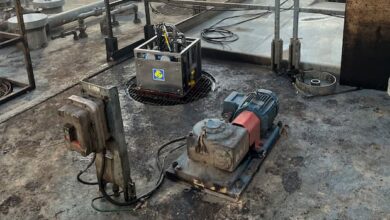Case study: new concentric expandable reamer tool used in Gulf of Mexico
By Steven Radford, Will Thompson, Hughes Christensen; Mark Jenkins, INTEQ
In the deepwater Green Canyon section of the Gulf of Mexico, an operator lost 10,000 bbl of synthetic oil-base drilling mud in one well before finally abandoning the project. In cooperation with two Baker Hughes companies – Hughes Christensen and INTEQ – the operator began a drilling improvement project in a new well adjacent to the previous one.
On this new well, water-base mud was to be used with an additive to reduce shale balling. The operator realized that the very reactive gumbo shale would be a risk and that hole swabbing may occur. One objective was to complete the well without excessive mud losses.
A second but overriding objective was to overcome previous problems encountered with concentric reamers available in the industry. On previous wells, concentric reamers had caused excessive vibration, leading to failure of downhole components, including rotary steerable systems.
To overcome this problem, the operator chose to use a new reamer from Hughes Christensen, the GaugePro XPR expandable reamer. The risks were the same as using any new downhole tool: more vibration, potential lost time, premature activation and casing damage, and failure to activate or failure to open the hole. The most serious risk would be having a tool that would fail to retract up into the casing.
After examining the reamer, however, the operator judged it to be rugged and simple with minimal risk.
reamer availability
Historically, concentric underreaming has been plagued by several challenges. Some reamers, especially earlier models used after drilling a hole, were not rugged and failed downhole, leaving parts behind to fish out. Some current industry concentric reamers have complex functionality, requiring a fine balance of WOB, flow and pressure drops in order to properly activate and operate. Some have multiple sliding mandrels with close tolerances that have problems closing after use because of solids accumulation. Some reamers require lower flow rates while drilling out the casing plug and a higher flow rate to activate the reamer, sometimes failing to open and remain closed during the entire run. Some reamers use hydraulic pistons for cutter blades that are difficult to close and pull into casing after drilling with water-base mud. Some reamers in the market have small and less effective cutter blocks that allow only a few PDC cutters, reducing their life and cutting efficiency. Tool failures have occurred with parts left in the hole, seal washouts and even twist-offs.
Lastly, downhole vibration while reaming has plagued the industry for years, causing BHA component failure and reduced drilling efficiency, even tools lost in the hole. Unstable cutting structures and improperly designed BHAs have led to these and other dysfunctions. With this background of unresolved reamer issues, the operator decided to try a new tool.
Underreamer Description
The operator selected the Hughes Christensen GaugePro XPR to drill a 10 5/8-in. pilot hole and ream a 12 ¼-in. borehole. The simple design appeared to be rugged and reliable (Figure 1). Activation occurs by dropping a ball into the drillstring, which seats in a sleeve, shears precision shear screws, and allows pressure to lift an annular piston attached to cutter blocks. A significant pressure rise and sharp decrease are seen on surface gauges.
Tool features include stabilization pads above and below the cutter blocks to stabilize drilling out the casing plug and protect the cutters. After activating the tool, the lower stabilizer pad is a key element in a smooth, stable reaming operation. Stabilization also is optimized with a cutting structure designed by a bit company.
The cutter profile and gauge pads are designed for stability.
The reamer designs are tested in the same facilities as drill bits, showing the same good stability as equivalently sized drill bits. The cutting structure includes a primary and a recessed secondary row of premium-grade PDC cutters designed for stability, durability and cutting efficiency.
Nozzles are designed using computational fluid dynamics technology. The reamer body structure meets appropriate downhole tool design standards evaluated with finite element analysis. One important feature is that the reamer body has no welding at any point of the construction, eliminating any potential heat-affected zone fatigue cracking. Other downhole tools have failed with cracking adjacent to welds.
As the pressure lifts the annular piston, the attached cutter blocks slide up a track angled only a few degrees. The pressure plus the vector forces of cutting maintain the blocks in the cutting position.
Most other reamers have been developed over years of trial and error on customer rigs. The GaugePro XPR reamer was developed and optimized over several years of testing on a full-scale, Baker Hughes-owned drilling rig in Oklahoma, drilling over 26,500 ft in 19 wells. Drilled formations include hard sandstones to 30,000 psi UCS, siltstone, limestone and coal.
Green Canyon Block 82
The interval objectives for the operator included:
• Drilling out from 11 7/8-in. liner set at 9,510 ft.
• Using a special additive to water-base mud to prevent severe fluid loss.
• Triggering the reamer to activate and seeing positive surface indication.
• Drilling and enlarging the 3,300-ft interval in one run.
• Preventing BHA vibration through better reamer and BHA design.
• Drilling interbedded sand/gumbo shale layers effectively.
• Pulling into casing and out of the hole without issues.
• Re-running the same reamer in a modified BHA to eliminate some of the rathole at the end of the run.
BHA
The pilot bit was a Hughes Christensen MX-1 (IADC Type 117) steel tooth bit synchronized to the reamer utilizing the philosophy described in IADC/SPE 112647, “A Systematic Approach to a Better Understanding of the Concentric Hole-Opening Process Utilizing Drilling Mechanics and Drilling Dynamics Measurements Recorded Above and Below the Reamer,” from the 2008 IADC/SPE Drilling Conference. This technique of synchronization was described for PDC bits but works equally well here.
The pilot bit was relatively non-aggressive, allowing most of the weight to be carried on the bit rather than the reamer. This prevented drill-off, and BHA whirl and vibration. Stability was improved by locating stabilizers above the AutoTrak rotary closed-loop system above the MWD/VSS package and below the reamer. A final stabilizer was placed 30 ft above the concentric reamer to add some degree of stabilization in the enlarged hole. The reamer was located 80 ft above the pilot bit (Figure 2).
The hole was drilled at an inclination of 17°, dropping to 10° over the 3,373 ft drilled, turning from azimuth of 270° to 310°. The water-base mud was pumped at 750 gal/min with 20% exiting through three #8 reamer nozzles and 80% through the pilot bit’s three #18 and one #14 nozzles. The operation required 102 hrs of drilling to complete, for an average ROP of 33.1 ft/hr with an average 20 klb WOB and up to 130 rpm, drilling relatively soft interbedded sand/shale sequences of UCS 1,000-4,000 psi in mostly highly reactive gumbo shale. The stabilizers, reamer and bit were severely balled when taken out of hole (Figure 3).
The water-base mud, even with the additive, couldn’t prevent the shale balling. This was a problem throughout the drilling process, but the goal of insignificant fluid loss was achieved.
The well was successfully completed. However, backreaming the majority of the hole and two short trips into casing were required while drilling to clean the shale from the BHA components. While in the casing, rotating and reciprocating the pipe, some circulation was allowed. Because of miscommunication, too much flow was pumped and the cutter blades were partially expanded, damaging some of the gauge cutters and resulting in a reamer dull grade of 0-3-CT-G (Figure 4).
Casing damage was not reported. The bit was dull graded as 2-1-WT-A after this long roller cone bit run (Figure 5).
Run analysis and offsets
All well objectives listed were achieved, though there were not good, comparable offsets available with data. However, the operator had experienced vibration damage to previous BHAs because of vibration from concentric reamers. There was no damage to the BHA components on this run, and there was negligible vibration. This was attributed to a properly stabilized BHA: a more stable reamer design and proper reamer-bit aggressiveness synchronization.
Although the operator had experienced previous reamer malfunction on prior wells and was aware of chronic problems, this reamer activated properly. It initially signaled triggering with a large pressure spike, drilled an in-gauge hole, and showed no drag pulling multiple times into casing even though it was severely balled up with shale.
Figure 6 shows a well log of a typical 300-ft section of the case study well, including shale, a sandstone stringer and mixed shale-sand. The full-gauge caliper plot is typical of the full well. The operator had no problems later getting casing to bottom. Figure 7 shows the same section of well as verified by the Gamma trace.
Notable is the trace titled SSLIP tracking stick-slip vibration. On a 1-10 unitless scale, this vibration was mostly between 0 and 2, with rare indications of 3. This is typical of the full well. Damage is typical with readings of 6-10. The trace titled “Lat Vib gravity” shows lateral vibration between 0.3 g and 0.5 g – virtually no vibration. Even more passive was the axial vibration in the last trace, with less than 0.2 g. Experience would have predicted much more lateral vibration when the pilot bit entered the harder stringer and 80 ft later when the reamer passed the same point. Vibration was insignificant in both cases.
Conclusions
• Although some concentric underreamers have had difficulty triggering and closing in gumbo shale, this reamer exhibited no problems with activation, deactivation or reliability. No overpull was seen pulling into casing.
• No unusual fluid losses were experienced with this water-base mud, although BHA shale balling and hole swabbing were problems.
• Vibration was negligible throughout the run, including through the sandstone stringers.
• The reamer disassembly showed no internal wear or tool damage other than gauge cutters as noted.
• The caliper log showed full-sized hole, and the casing went to bottom without problem.
This article is based on a presentation made at the 2008 DEA Workshop, 17-18 June 2008, Galveston, Texas.





very valuable article.